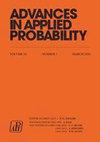PDE for the joint law of the pair of a continuous diffusion and its running maximum
IF 1.2
4区 数学
Q3 STATISTICS & PROBABILITY
引用次数: 2
Abstract
PDE为连续扩散对及其运行最大值的联合律
设X是d维扩散,M是其第一个分量的运行上确界。在本文中,我们证明了对于任何$t>0,$对$\big(M_t,X_t\big)$的密度(相对于$(d+1)$维Lebesgue测度)是闭集$\big上的Fokker–Planck偏微分方程的弱解。
本文章由计算机程序翻译,如有差异,请以英文原文为准。
求助全文
约1分钟内获得全文
求助全文
来源期刊

Advances in Applied Probability
数学-统计学与概率论
CiteScore
2.00
自引率
0.00%
发文量
64
审稿时长
6-12 weeks
期刊介绍:
The Advances in Applied Probability has been published by the Applied Probability Trust for over four decades, and is a companion publication to the Journal of Applied Probability. It contains mathematical and scientific papers of interest to applied probabilists, with emphasis on applications in a broad spectrum of disciplines, including the biosciences, operations research, telecommunications, computer science, engineering, epidemiology, financial mathematics, the physical and social sciences, and any field where stochastic modeling is used.
A submission to Applied Probability represents a submission that may, at the Editor-in-Chief’s discretion, appear in either the Journal of Applied Probability or the Advances in Applied Probability. Typically, shorter papers appear in the Journal, with longer contributions appearing in the Advances.
 求助内容:
求助内容: 应助结果提醒方式:
应助结果提醒方式:


